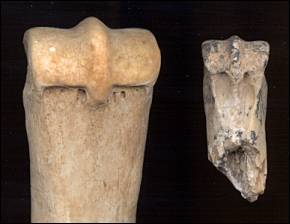

Ever see the common diagram of horse evolution? You know, the one where the skull, teeth, and feet of a tiny ancestor are at the bottom, and then there is a sequence of increasingly horse-like fossils leading to the horse of today at the top? Just goes to show that scientists quite often aren't good communicators. What's wrong with the picture? Not much with what is there, but a lot with what is missing. The diagram makes it look like the modern horse was the aim of evolution—what it doesn't show is all the other branches that led to other kinds of horses. Horse evolution would better be pictured as a bush rather than as a ladder.
Eroding out of the late Pliocene beds of the Southwest and Chihuahua,
fossil remains deny the idea that large, one-toed horses are the epitome of horse-ness.
Were we in the Chihuahuan Desert region a mere 2 million years ago, the unintentional
deceitfulness of this picture of horse evolution would have been apparent, as herds of
lightly-built, small, three-toed Nannippus graced the landscape.

Contributor: Arthur H. Harris, Laboratory for Environmental Biology, Centennial Museum, University of Texas at El Paso.
Desert Diary is a joint production of the Centennial Museum and KTEP National Public Radio at the University of Texas at El Paso.

Left: Distal end of the metapodial of a medium size, one-toed horse (Equus niobrarensis, , UTEP Paleobiology Collection 22-678). Right: the same element (broken perhaps 20% from the end) of Nannippus, UTEP Paleobiology Collection 9-11, a three-toed horse.
MacFadden, B. J. 1992. Fossil horses. Systematics, paleobiology, and evolution of the family Equidae. Cambridge University Press, Cambridge, 369 pp.
Horse Evolution. Kathleen Hunt's article on Talk.Origins.